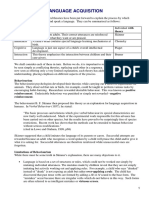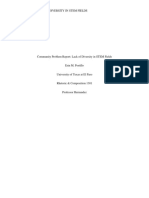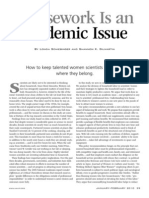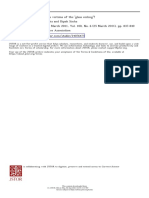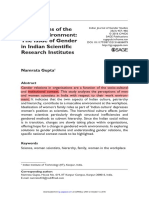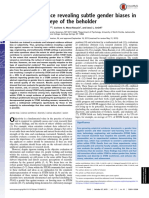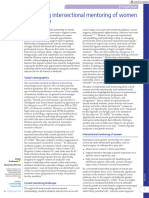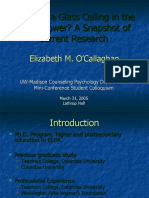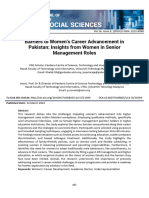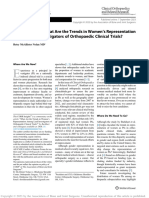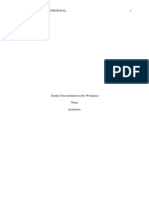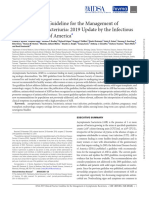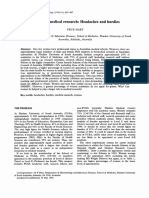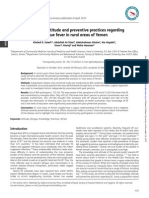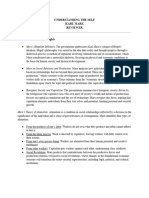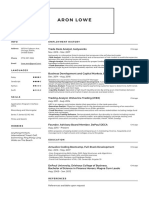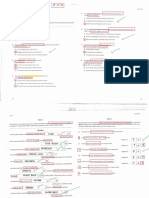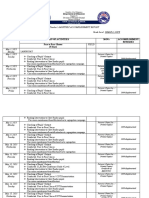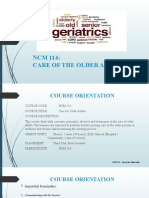Wanted Women in Research
Wanted Women in Research
Uploaded by
luishelCopyright:
Available Formats
Wanted Women in Research
Wanted Women in Research
Uploaded by
luishelCopyright
Available Formats
Share this document
Did you find this document useful?
Is this content inappropriate?
Copyright:
Available Formats
Wanted Women in Research
Wanted Women in Research
Uploaded by
luishelCopyright:
Available Formats
e d i to r i a l
Wanted: women in research
Women are still underrepresented in senior academic positions in science. A fundamental restructuring of the way
scientists are evaluated is essential to remedy this disparity.
M
arch 8th marks International Womens Day. Data from the osition after earning a PhD than married men with children and
p
US Bureau of Labor Statistics suggests that there is much to 27% less likely than men to achieve tenure on entering a tenure-track
celebrate: in the US, women made up about 47% of the overall job. A 2007 survey of 1,300 NIH postdoctoral fellows found a similar
workforce and 51% of the workforce in management and professional trend; women, particularly those with children, were less likely to
occupations. Closing the gender gap in the workplace represents one of consider a principal investigator position (45% compared with 69%
2010 Nature America, Inc. All rights reserved.
the biggest social changes of the last few decades. For women in scientific of men with children).
research, h owever, the news is not all good. Women still make-up only Establishing better childcare options will certainly help, but is
about 19% of tenured US National Institutes of Health (NIH) staff and unlikely to change the status quo much. No matter how good the
only about 18% of tenured academics in the European Union. Gender quality of childcare, women still need to take time out to have children.
stereotypes alone are unlikely to explain much of this disparity. Instead, Even if provisions like a flexible tenure clock are made, taking time
a fundamental restructuring of the way academic science is conducted away from the lab can only hinder success in a competitive research
and how individual scientists are evaluated is necessary if we are to fully environment; for example, papers may get scooped or delayed.
embrace women in all walks of science. Unless factors other than publication record, such as mentorship,
Certainly, we have made progress in increasing the participation of collaboration and innovation, are given prominence in measuring
women at the early stages of the research career pipeline. The National the productivity of a scientist, women (and men) who take time away
Science Foundation reports that women now account for 56% of all for other obligations will invariably be at a disadvantage. Encouraging
science and engineering undergraduate degrees. In 1973, only 20% of men to take similar amounts of time off for childcare responsibilities
all science doctorates were awarded to women; the number was closer might help level the playing field.
to 50% in 2005. The proportion of women employed in academic Lack of confidence is also another key factor preventing the rise
positions, however, rose only ~20% during the same period, from of women. In a recent survey of NIH fellows, both men and women
about 10% in 1973 to 32% in 2005. The drop-off rate is dramatic reported a similar self-assessment of professional skills (such as grant
as women climb the academic ladder; for example, women received writing, oral presentations, etc), but only 40% of women (as opposed
63% and 54% of NIH and National Science Foundations predoctoral to 59% of men) were confident that they would obtain a principal
awards, respectively, in 2007, but only 25% and 23%, respectively, of investigator position. Assuming that they were successful in obtaining a
the faculty grants awarded that year. faculty position, only 45% of women (relative to 55% of men) reported
The reasons for this attrition have been hotly debated, but it seems confidence that they would get tenure. An analysis of research grant
likely that it cannot be attributed solely to gender prejudices and applications from Harvard affiliated institutions showed a similar
stereotype. Bibliometric studies have concluded that gender has no effect trend; women were less likely to submit applications, applied for fewer
on peer review (Nature 459, 602, 2009). We have previously reported years of funding and requested less research money, despite an absence
that gender also does not seem to influence chances of publication at of bias in the grant-reviewing process.
Nature Neuroscience (Nat. Neurosci. 9, 853, 2006). There are no quick fixes to close the gender gap, and women
There is even some evidence that women may be at a slight advantage abandon academic science careers for complex reasons. Unless there is
when it comes to competing for faculty positions. A 2009 report by the a drastic restructuring of the way academic research is conducted, such
US National Academies, based on surveys of 1,800 faculty members, as encouraging part-time work, rewarding smaller labs, encouraging
found that women were more likely to have been interviewed for tenure more collaborations and lab-sharing, and a fundamental overhaul of
track positions (2% more than their application rate), more likely to how scientists are evaluated and rewarded, women may never make up
receive an offer (10% more than their application rate) and as likely to even close to 50% of this pipeline. Given the tremendous competition
receive tenure. The report concluded that at many critical transition for funding and the limited funds available for research, one could
points in their academic careers (), women appear to have fared argue that, so long as these highly trained women are finding attractive
as well as or better than men. Despite this absence of bias, however, jobs elsewhere, there is no real urgency in demanding change.
fewer women applied for tenure-track positions in the first place, and However, this would be shortsighted. A strong scientific research base
women were likely to remain as assistant professors for longer and to is at the heart of a strong economy, and it would be foolish to keep a
drop out in greater numbers. system in place that consistently bleeds some of its best minds. Just as
Why is the pipeline then so leaky for women? Children are we celebrate women bridging the gender gap in the general workforce,
undoubtedly a factor; a 2007 survey concluded that women who were we need to ensure that the scientific enterprise welcomes women at
married with children were 35% less likely to enter a tenure-track all levels. L
nature neuroscience volume 13 | number 3 | march 2010 267
You might also like
- Theroies of Language AcquisitionDocument4 pagesTheroies of Language AcquisitionJunelyn Gapuz Villar100% (1)
- Quarter 2 English 7 LAS 3Document8 pagesQuarter 2 English 7 LAS 3RutchelNo ratings yet
- Summary:: Case 44: Where Are The Women?Document6 pagesSummary:: Case 44: Where Are The Women?tigin kultiginNo ratings yet
- Women Science Professionals in IndiaDocument12 pagesWomen Science Professionals in IndiaCheshta AroraNo ratings yet
- DR AcDocument2 pagesDR AcGaurav GuptaNo ratings yet
- Barriers To Pursing A Career in Surgery Alexandra MDocument7 pagesBarriers To Pursing A Career in Surgery Alexandra MSusan FernándezNo ratings yet
- Sciene and WomenDocument5 pagesSciene and WomenAlicia AlmeidaNo ratings yet
- Women Scientists ProjectDocument81 pagesWomen Scientists ProjectReema NegiNo ratings yet
- Running Head: Lack of Diversity in Stem FieldsDocument7 pagesRunning Head: Lack of Diversity in Stem Fieldsapi-383565972No ratings yet
- Men and Women Differ in Their Perception of Gender Bias in Research InstitutionsDocument21 pagesMen and Women Differ in Their Perception of Gender Bias in Research InstitutionsPsicología AntirracistaNo ratings yet
- Academic Issue: Housework Is AnDocument6 pagesAcademic Issue: Housework Is Anapi-26010865No ratings yet
- PNAS 2012 Moss Racusin 16474 9 PDFDocument6 pagesPNAS 2012 Moss Racusin 16474 9 PDFRuth LopezNo ratings yet
- Age, BurnoutDocument20 pagesAge, BurnoutCatarinaNhuNo ratings yet
- Gender Work Organization - 2018 - Sattari - Gender in Academic STEM A Focus On Men FacultyDocument22 pagesGender Work Organization - 2018 - Sattari - Gender in Academic STEM A Focus On Men FacultyRoseli MachadoNo ratings yet
- Do Women and Men Occupy The Same Place On The World Science ?Document5 pagesDo Women and Men Occupy The Same Place On The World Science ?xsr98xwjc4No ratings yet
- Maham_Term report of sociology-Final (updated by maham)Document18 pagesMaham_Term report of sociology-Final (updated by maham)sumbel tararNo ratings yet
- Are Indian Women Scientists Victims of The 'Glass Ceiling'Document5 pagesAre Indian Women Scientists Victims of The 'Glass Ceiling'isha ipsitaNo ratings yet
- Women and Science Part 3Document3 pagesWomen and Science Part 3Vio LetraNo ratings yet
- Perceptions of The Work Environment Namrata GuptaDocument30 pagesPerceptions of The Work Environment Namrata GuptaavriqueNo ratings yet
- 06 - Chapter 1Document26 pages06 - Chapter 1Jhuma DasNo ratings yet
- Jesús Salazar English 7Document10 pagesJesús Salazar English 7Amparo Abello AlfonsoNo ratings yet
- Biased Sampling: No Homer Simpson Effect' Among High AchieversDocument2 pagesBiased Sampling: No Homer Simpson Effect' Among High AchieversFabiani Figueiredo CaseiraNo ratings yet
- Gender Disparity in An Academic Hospital: Female Health Care Professionals PerspectiveDocument7 pagesGender Disparity in An Academic Hospital: Female Health Care Professionals PerspectiveIJAR JOURNALNo ratings yet
- Cognition and The BrainDocument12 pagesCognition and The BrainInterfan_allinNo ratings yet
- Gender Stereotypes Are Alive - Well - and Busy Producing Workplace Discrimination PDFDocument6 pagesGender Stereotypes Are Alive - Well - and Busy Producing Workplace Discrimination PDFELMERNo ratings yet
- Scientists Want More Children: Elaine Howard Ecklund, Anne E. LincolnDocument4 pagesScientists Want More Children: Elaine Howard Ecklund, Anne E. LincolnDeepak Ranjan SahooNo ratings yet
- Handley Brown Moss-Racusin Et Al 2015 PNASDocument6 pagesHandley Brown Moss-Racusin Et Al 2015 PNASPatrícia MoreiraNo ratings yet
- Not Yet 50/50' - Barriers To The Progress of Senior Women in The Australian Public ServiceDocument10 pagesNot Yet 50/50' - Barriers To The Progress of Senior Women in The Australian Public ServiceHussain khawajaNo ratings yet
- Medical Journal of Australia - 2024 - Prathivadi - Supporting Intersectional Mentoring of Women in MedicineDocument3 pagesMedical Journal of Australia - 2024 - Prathivadi - Supporting Intersectional Mentoring of Women in MedicineIndra SanjayaNo ratings yet
- Degrees of Freedom: Your Future in Biomedical Research: EditorialDocument4 pagesDegrees of Freedom: Your Future in Biomedical Research: Editorialayush guptaNo ratings yet
- ScienceFacultysSubtleBiasesFavorMaleStudents FullDocument7 pagesScienceFacultysSubtleBiasesFavorMaleStudents Fullanastasia.silbersteinNo ratings yet
- tmp1ECF TMPDocument4 pagestmp1ECF TMPFrontiersNo ratings yet
- Women in Science WorksheetDocument2 pagesWomen in Science WorksheetJanna RickNo ratings yet
- Digitalcommons@University of Nebraska - Lincoln Digitalcommons@University of Nebraska - LincolnDocument5 pagesDigitalcommons@University of Nebraska - Lincoln Digitalcommons@University of Nebraska - LincolnFarid HosniNo ratings yet
- Is There A Glass Ceiling in The Ivory Tower? A Snapshot of Current ResearchDocument19 pagesIs There A Glass Ceiling in The Ivory Tower? A Snapshot of Current ResearchFunk Sunny VermaNo ratings yet
- NatureDocument9 pagesNatureSIMONE ALVES PACHECO DE CAMPOSNo ratings yet
- Done A - Study - of - Factors - Affecting - WDocument12 pagesDone A - Study - of - Factors - Affecting - WĐan TâmNo ratings yet
- Dr. Vijaya Lakshmi Pothuraju 4 - With-cover-page-V2Document11 pagesDr. Vijaya Lakshmi Pothuraju 4 - With-cover-page-V2Aishwarya MotwaniNo ratings yet
- Factors That Affect Scientific Publication in AfriDocument15 pagesFactors That Affect Scientific Publication in Afriaca.to.youNo ratings yet
- Add Women, Transform Academe: Barbara A. Baker and Paula BobrowskiDocument3 pagesAdd Women, Transform Academe: Barbara A. Baker and Paula BobrowskiHussain khawajaNo ratings yet
- Beaman Et Al (2012)Document15 pagesBeaman Et Al (2012)Phenomenal OneNo ratings yet
- Williams Ceci 2011 Understanding Current Causes of Women S Underrepresentation in ScienceDocument6 pagesWilliams Ceci 2011 Understanding Current Causes of Women S Underrepresentation in SciencegualfigNo ratings yet
- Rogerian Essay Drraft 1Document5 pagesRogerian Essay Drraft 1Madisyn Grace HurleyNo ratings yet
- Hayes EditorialDocument3 pagesHayes EditorialSex & Gender Women's Health CollaborativeNo ratings yet
- Women in ScienceDocument9 pagesWomen in SciencesaducaNo ratings yet
- The Gender Dimension of Plagiarism: A Case StudyDocument3 pagesThe Gender Dimension of Plagiarism: A Case StudyIJELS Research JournalNo ratings yet
- Women in LeadershipDocument16 pagesWomen in LeadershipbusinessNo ratings yet
- Barriers To Womens Career Advancement in Pakistan Insights From Women in Senior Management RolesDocument14 pagesBarriers To Womens Career Advancement in Pakistan Insights From Women in Senior Management RolesAbdullah AfzalNo ratings yet
- Outside The Lab With Dr. Kishana Taylor: Upcoming EventsDocument10 pagesOutside The Lab With Dr. Kishana Taylor: Upcoming Eventsapi-353949457No ratings yet
- Corr Insights What Are The Trends in Women s.10Document2 pagesCorr Insights What Are The Trends in Women s.10danish7865No ratings yet
- Sequential Logistic Regression - A Method To Reveal Subtlety in SeDocument10 pagesSequential Logistic Regression - A Method To Reveal Subtlety in SeUOM LoversNo ratings yet
- Tannenbaum Et Al 2019 NatureDocument10 pagesTannenbaum Et Al 2019 Nature溥天 王No ratings yet
- Leadership Journeys - Reflections On Experiences and Challenges FRDocument26 pagesLeadership Journeys - Reflections On Experiences and Challenges FRdwi permanaNo ratings yet
- Against the Odds self efficacy beliefs of women in mathematical scientific and technological careersDocument32 pagesAgainst the Odds self efficacy beliefs of women in mathematical scientific and technological careerscarlos.pastor03No ratings yet
- Endocr 4Document16 pagesEndocr 4Bogdan GavrilNo ratings yet
- A Feminist Approach To ResearchDocument3 pagesA Feminist Approach To ResearchBeatriz MontenegroNo ratings yet
- Chalanges of Work Life Balance For WomenDocument7 pagesChalanges of Work Life Balance For WomenRise n shine SkyNo ratings yet
- Invisible Women Exposing Data Bias in A World DesiDocument1 pageInvisible Women Exposing Data Bias in A World DesiSimra Shahid BawanyNo ratings yet
- Gender Discrimination in The WorkplaceDocument6 pagesGender Discrimination in The WorkplacekenNo ratings yet
- Unit 2 2Document4 pagesUnit 2 2api-438344384No ratings yet
- Wew Categories Are Not Enough _ Rethinking the Measurement of Sex and Gender in Social SurveysDocument27 pagesWew Categories Are Not Enough _ Rethinking the Measurement of Sex and Gender in Social SurveysNJNo ratings yet
- Inferior: How Science Got Women Wrong-and the New Research That's Rewriting the StoryFrom EverandInferior: How Science Got Women Wrong-and the New Research That's Rewriting the StoryRating: 4 out of 5 stars4/5 (137)
- Ciy 1121Document28 pagesCiy 1121luishelNo ratings yet
- The Development of Benign Prostatic Hyperplasia Among Volunteers in The Normative Aging StudyDocument13 pagesThe Development of Benign Prostatic Hyperplasia Among Volunteers in The Normative Aging StudyluishelNo ratings yet
- Revised Global Consensus Statement On Menopausal Hormone TherapyDocument4 pagesRevised Global Consensus Statement On Menopausal Hormone TherapyluishelNo ratings yet
- Hemoptysis in A Healthy 13-Year-Old Boy: PresentationDocument5 pagesHemoptysis in A Healthy 13-Year-Old Boy: PresentationluishelNo ratings yet
- DSM-5 and Neurocognitive DisordersDocument6 pagesDSM-5 and Neurocognitive DisordersluishelNo ratings yet
- International Variation in Asthma and Bronchiolitis GuidelinesDocument16 pagesInternational Variation in Asthma and Bronchiolitis GuidelinesluishelNo ratings yet
- 11 - Nutrition and Intelligence - Berkman Lancet 2002Document9 pages11 - Nutrition and Intelligence - Berkman Lancet 2002luishelNo ratings yet
- Microbial Source Tracking A Tool For Identifying Sources of Microbial Contamination in The Food ChainDocument35 pagesMicrobial Source Tracking A Tool For Identifying Sources of Microbial Contamination in The Food ChainluishelNo ratings yet
- Women in Medical Research Headaches and HurdlesDocument3 pagesWomen in Medical Research Headaches and HurdlesluishelNo ratings yet
- Knowledge, Attitude and Preventive Practices Regarding Dengue Fever in Rural Areas of YemenDocument6 pagesKnowledge, Attitude and Preventive Practices Regarding Dengue Fever in Rural Areas of YemenluishelNo ratings yet
- Uts Karl Marx ReviewerDocument2 pagesUts Karl Marx ReviewerLatifah LuarcaNo ratings yet
- Extlistjuly2023 DiscontDocument21 pagesExtlistjuly2023 DiscontHien PhamNo ratings yet
- Imat New Guide 2022Document10 pagesImat New Guide 2022selNo ratings yet
- Useful Vocabulary For The Resume and InterviewDocument10 pagesUseful Vocabulary For The Resume and InterviewLucas AcostaNo ratings yet
- The Independence of Post Sectio Caesarea Mother With Discharge Planning Based On Orem's Self Care TheoryDocument9 pagesThe Independence of Post Sectio Caesarea Mother With Discharge Planning Based On Orem's Self Care TheoryJurnal Ners UNAIRNo ratings yet
- Aron Lowe - ResumeDocument1 pageAron Lowe - ResumeAron LoweNo ratings yet
- B2 Listening FCE For Schools 1 Test 1 QuestionsDocument4 pagesB2 Listening FCE For Schools 1 Test 1 QuestionsÁlvaro Izquierdo DíazNo ratings yet
- Module 1Document38 pagesModule 1Princess WeiyoungNo ratings yet
- Dharshini Resume NewDocument2 pagesDharshini Resume NewKANITHI SANDEEP KUMARNo ratings yet
- Preparation Worksheets For Grade 3Document23 pagesPreparation Worksheets For Grade 3Chenta Love100% (1)
- Hayley Roy ResumeDocument1 pageHayley Roy Resumeapi-622216865No ratings yet
- Georgia Performance Standards Social Studies 9-12Document9 pagesGeorgia Performance Standards Social Studies 9-12api-282062243No ratings yet
- Ex4949 PDFDocument13 pagesEx4949 PDFswatheekrishnaNo ratings yet
- AIPGMEE 2015 Book PDFDocument72 pagesAIPGMEE 2015 Book PDFChaudhary Gaurav DalalNo ratings yet
- Accomplishment Report-May 2023Document41 pagesAccomplishment Report-May 2023Princess Darling SabugaNo ratings yet
- Training Within IndustryDocument8 pagesTraining Within IndustryIgor GrishkoNo ratings yet
- CO1 - Give Technical and Operational DefinitionDocument9 pagesCO1 - Give Technical and Operational Definitionmynie.regalaNo ratings yet
- Concepts, Principles & Theories in The CareDocument28 pagesConcepts, Principles & Theories in The CareMary Lenore Hernandez-amamanglon100% (2)
- Math Unit Organizer 1Document4 pagesMath Unit Organizer 1api-261022269No ratings yet
- Examen de InglésDocument3 pagesExamen de InglésTyson FerreyraNo ratings yet
- Annotated Bibliography:: Islam and Muslims in CanadaDocument38 pagesAnnotated Bibliography:: Islam and Muslims in CanadaAnonymous Fwe1mgZNo ratings yet
- ps1 Northern Lights ArtDocument2 pagesps1 Northern Lights Artapi-487640722No ratings yet
- Report Writing WorksheetsDocument4 pagesReport Writing WorksheetsIzzanie Qashrina100% (1)
- GlossaryDocument27 pagesGlossary29_ramesh170No ratings yet
- The Best Kindergarten You'Ve Ever Seen: Takaharu Tezuka at TedxkyotoDocument2 pagesThe Best Kindergarten You'Ve Ever Seen: Takaharu Tezuka at TedxkyotoThomas ClarkeNo ratings yet
- 2020 AL Physics Marking Scheme - Tamil MediumDocument76 pages2020 AL Physics Marking Scheme - Tamil MediumGowrisankar SivakumarNo ratings yet
- Activity 3 - Patterns, Mathe Translations - Answer KeyDocument2 pagesActivity 3 - Patterns, Mathe Translations - Answer KeyJustin Paul HibionadaNo ratings yet
- Documentation Checklist For AI SystemsDocument2 pagesDocumentation Checklist For AI Systemsgardening.undergroundNo ratings yet
